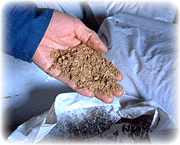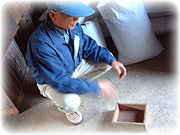 Autumn - winter is the most critical season to building soil that will directly affect the quality of the tea leaves to be harvested in the following spring. At Suzuki's farm, organic fertilizes are prepared by fermenting a mixture of sake lees, fish mill, rice bran, kelp, soy pulp, waste vegetables, etc. added with certain strains of yeast, lactobacillus, and "indigenous" microbes collected from his land.
Autumn - winter is the most critical season to building soil that will directly affect the quality of the tea leaves to be harvested in the following spring. At Suzuki's farm, organic fertilizes are prepared by fermenting a mixture of sake lees, fish mill, rice bran, kelp, soy pulp, waste vegetables, etc. added with certain strains of yeast, lactobacillus, and "indigenous" microbes collected from his land.
"The nearby bamboo bush is the best place to collect the most powerful combination of bacteria for my land. I have experimented with different ready-made microbial blends, but the fermentation process seems to be most effectively facilitated by the indigenous ones," said Mr. Suzuki.
 "What we have been doing for generations is to put cooked rice in a wooden box and tightly cover it with a piece of rice paper so that insects and other crawling bugs would not get in. Then we place the box in the bamboo bush and cover it with grass. In a few days, you'll see a white fuzzy growth on the surface of the rice... that's 'indigenous microbial species' you cannot find elsewhere. I take them home and breed them, as they seem to know how best to enhance my land."
"What we have been doing for generations is to put cooked rice in a wooden box and tightly cover it with a piece of rice paper so that insects and other crawling bugs would not get in. Then we place the box in the bamboo bush and cover it with grass. In a few days, you'll see a white fuzzy growth on the surface of the rice... that's 'indigenous microbial species' you cannot find elsewhere. I take them home and breed them, as they seem to know how best to enhance my land."
